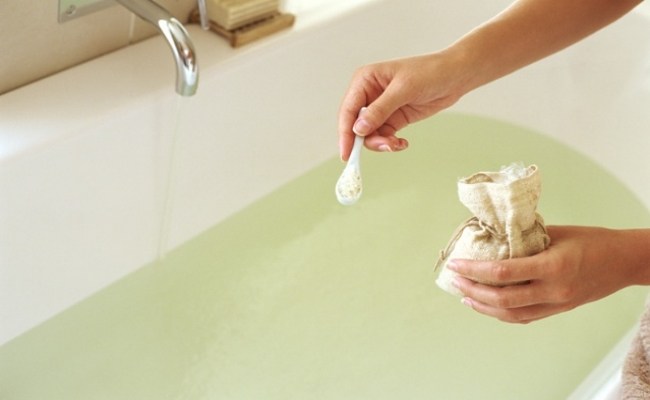Epsom salt baths have long been praised for their numerous health benefits. In this comprehensive guide, we will explore the science behind Epsom salt baths and provide step-by-step instructions on how to prepare a therapeutic bath for maximum benefits.
What Is Epsom Salt?
Epsom salt, scientifically known as magnesium sulfate, is a mineral compound that has been used for centuries for its various medicinal properties. Unlike regular table salt, Epsom salt contains magnesium and sulfate ions, which are absorbed through the skin during a bath.
Magnesium is an essential mineral that plays a crucial role in over 300 biochemical reactions in the body. It is involved in muscle and nerve function, energy production, and the synthesis of DNA and proteins.
Sulfate, on the other hand, is important for detoxification processes in the body and is required for the formation of joint proteins and the production of digestive enzymes.

The Health Benefits of Epsom Salt Baths
1. Detoxification and its effects on the body
Toxins can accumulate in our bodies from various sources such as pollution, processed foods, and exposure to chemicals. These toxins can place a burden on our organs and contribute to chronic health issues.
Epsom salt baths are believed to aid in detoxification by promoting the elimination of toxins from the body. The warm water and the magnesium sulfate in Epsom salt help increase circulation. This in turn supports the body’s natural detoxification processes.
2. Muscle relaxation and relief from soreness
One of the most well-known benefits of Epsom salt baths is their ability to relax muscles and relieve soreness. The magnesium in Epsom salt helps reduce muscle tension and inflammation. This makes it a popular choice for athletes and individuals with muscle-related conditions.
When we experience muscle soreness or tension, it is often due to a buildup of lactic acid and a magnesium deficiency. Epsom salt baths can help replenish magnesium levels in the body, which is crucial for proper muscle function.
3. Epsom salt and stress reduction
Chronic stress can have a detrimental impact on both our physical and mental health. It can lead to increased muscle tension, elevated blood pressure, and a weakened immune system.
Epsom salt baths can be soothing, making them an excellent tool for stress reduction. The magnesium in Epsom salt helps promote the production of serotonin.
This is a neurotransmitter that contributes to feelings of relaxation and well-being. Taking the time to unwind in a warm bath with Epsom salt can be an effective way to alleviate stress and promote overall well-being.
4. Improved sleep quality and its importance
Sleep plays a vital role in our physical and mental health. It is during sleep that our bodies repair and restore themselves, leading to increased energy, improved cognitive function, and better overall mood.
However, many individuals struggle with sleep disturbances, such as insomnia or restless sleep. Epsom salt baths can help create an optimal sleep environment by inducing relaxation and reducing anxiety, allowing for a more restful and rejuvenating sleep.
5. Skin exfoliation and health
Our skin is the largest organ of our body and serves as a protective barrier against external elements. Over time, dead skin cells can accumulate on the surface, leading to dull and lackluster skin.
Epsom salt baths provide gentle exfoliation, helping to slough off dead skin cells and reveal brighter, smoother skin underneath. Additionally, the magnesium in Epsom salt has been shown to improve skin hydration and reduce inflammation, making it beneficial for individuals with skin conditions such as eczema or acne.
6. Potential benefits for specific health conditions
Arthritis is a condition characterized by joint inflammation and pain. Epsom salt baths can provide temporary relief by reducing inflammation and promoting joint mobility. The warm water and magnesium sulfate in Epsom salt helps relax muscles and soothe sore joints.
Psoriasis is a chronic autoimmune condition that affects the skin, causing red, scaly patches. Epsom salt baths can help soften the skin, reduce itchiness, and alleviate inflammation associated with psoriasis. The exfoliating properties of Epsom salt can also aid in the removal of dead skin cells, promoting healthier skin.
Fibromyalgia is a complex chronic pain condition that is often accompanied by muscle stiffness and tenderness. Epsom salt baths can provide relief by relaxing muscles, reducing pain, and promoting overall relaxation.
7. The role of magnesium absorption through the skin
One of the key benefits of Epsom salt baths is the absorption of magnesium through the skin. Magnesium plays a crucial role in various bodily functions, including muscle contractions, nerve function, and energy production. By soaking in an Epsom salt bath, you can increase your magnesium levels and support optimal health.
While magnesium can be obtained through diet by consuming magnesium-rich foods such as leafy greens, nuts, and whole grains, many individuals still fall short of the recommended daily intake. Absorbing magnesium through the skin via Epsom salt baths provides an additional avenue for replenishing magnesium levels in the body.

How to Prepare for an Epsom Salt Bath
To reap the full benefits of an Epsom salt bath, it’s essential to prepare it correctly. Here are some guidelines to follow:
- The right amount of Epsom salt to use: For a standard-sized bathtub, use 1-2 cups of Epsom salt. If you have a larger tub, adjust the amount accordingly.
- Optimal water temperature for absorption and comfort: Fill your bathtub with warm water, aiming for a temperature between 92 and 100 degrees Fahrenheit (33-38 degrees Celsius). This temperature range ensures optimal absorption of the magnesium sulfate while still providing comfort.
- Duration of the bath for maximum benefits: Soak in the Epsom salt bath for at least 12-15 minutes to allow your body to absorb the minerals fully. You can extend the duration if desired, but be cautious not to stay in the bath for too long, as it may lead to dehydration.
- Frequency of Epsom salt baths: The frequency of Epsom salt baths depends on individual needs and preferences. Some individuals may benefit from regular baths, while others may find occasional baths sufficient. Listen to your body and adjust accordingly.
Step-by-Step Instructions for an Epsom Salt Bath
Now that you understand the benefits and preparation guidelines, here’s a step-by-step guide to help you create a relaxing and therapeutic Epsom salt bath:
- Gather your supplies: You’ll need Epsom salt, a bathtub, and any additional items you’d like to enhance your bath experience, such as essential oils or candles.
- Fill the bathtub with warm water: Start filling your bathtub with warm water at the desired temperature, ensuring it covers your entire body when you’re sitting or lying down.
- Measure and add Epsom salt: While the tub is filling, measure out 1-2 cups of Epsom salt, depending on the size of your tub. Slowly pour the salt into the water, allowing it to dissolve.
- Enhance the experience: If desired, add a few drops of your favorite essential oil to the bathwater. Lavender, chamomile, and eucalyptus are popular choices known for their relaxing properties.
- Get in and relax: Once the tub is filled and the Epsom salt has dissolved, carefully step into the bath and find a comfortable position. Take deep breaths and allow yourself to fully relax.
- Enjoy the bath: Use this time to unwind, meditate, or simply enjoy the tranquility. You can also practice mindfulness techniques, such as focusing on your breath or repeating affirmations.
- Post-bath care and hydration: After your desired bath duration, carefully step out of the tub and rinse off any remaining salt residue. Remember to hydrate your body by drinking a glass of water to replenish any fluids lost during the bath.
How to Enhance Your Epsom Salt Bath Experience
While a basic Epsom salt bath can be incredibly beneficial on its own, there are several ways to enhance your bathing experience and amplify the benefits. Consider these tips to take your Epsom salt bath to the next level:
- Essential Oils and Aromatherapy: Add a few drops of your favorite essential oils to the bathwater for an aromatic experience. Lavender, chamomile, and eucalyptus are popular choices known for their relaxation and soothing properties.
- Combining Epsom Salt with Other Bath Additives: Experiment with other bath additives, such as bath bombs or natural oils, to create a personalized bathing ritual. These additional ingredients can further enhance the relaxation and therapeutic effects of your bath.
- Lighting and Music: Set the mood for a truly rejuvenating experience by dimming the lights or using candles. Play soft, calming music to create a tranquil ambiance that promotes relaxation and stress relief.
- Mindfulness and Meditation: Use your Epsom salt bath as an opportunity to practice mindfulness and meditation. Focus on your breath, engage your senses, and embrace the present moment. This can further enhance the relaxation and mental well-being benefits of your bath.
- Hydrate Before and After: Drinking a glass of water before and after your Epsom salt bath can help prevent dehydration. The warm water of the bath can cause you to sweat and lose fluids, so it’s important to stay hydrated.
- Set Aside Dedicated Bath Time: Create a ritual around your Epsom salt baths by setting aside dedicated time for yourself. Treat it as a self-care practice where you can unwind, disconnect from technology, and focus on your well-being.
By incorporating these tips into your Epsom salt bath routine, you can create a truly therapeutic and indulgent experience that nurtures your body and mind.
Safety Precautions and Contraindications
While Epsom salt baths are generally safe for most individuals, there are a few precautions to keep in mind:
- Who should avoid Epsom salt baths: Individuals with certain health conditions, such as kidney disease, diabetes, or high blood pressure, should consult their healthcare provider before taking Epsom salt baths. Pregnant women should also seek medical advice before using Epsom salt.
- Possible side effects and how to mitigate them: Some individuals may experience dry skin or itching after an Epsom salt bath. To mitigate these effects, moisturize your skin after the bath and ensure proper hydration.
- When to consult a healthcare provider: If you experience any unusual or severe symptoms after an Epsom salt bath, such as dizziness, nausea, or allergic reactions, seek medical attention immediately.
Additional Uses for Epsom Salt
Apart from baths, Epsom salt has various other uses:
- Foot soaks for foot health and relaxation: Soaking your feet in warm water with Epsom salt can help relieve foot pain, reduce inflammation, and soften calluses. Add a handful of Epsom salt to a basin of warm water and soak your feet for 15-20 minutes.
- Epsom salt in gardening: Epsom salt can be used as a natural fertilizer for plants, providing them with essential minerals like magnesium and sulfur. Sprinkle Epsom salt around the base of your plants or dissolve it in water and use it as a foliar spray.
- Homemade Epsom salt skincare recipes: Epsom salt can be incorporated into homemade skincare products, such as scrubs and masks, to exfoliate and nourish the skin. Mix Epsom salt with your favorite carrier oil, such as coconut oil or almond oil, to create a gentle exfoliating scrub.
FAQs
1. Can Epsom salt baths help with cellulite or stretch marks?
While Epsom salt baths can improve the appearance of the skin and promote skin health, they cannot completely eliminate cellulite or stretch marks. These conditions are influenced by multiple factors and may require a combination of treatments for optimal results.
2. How often should you take an Epsom salt bath?
The frequency of Epsom salt baths depends on your individual needs and preferences. Some people enjoy a weekly Epsom salt bath, while others incorporate them into their routine more frequently. Listen to your body and adjust accordingly.
3. Are there different types of Epsom salt for different uses?
While there are various types of Epsom salt available, such as scented or infused varieties, they all contain the same essential components. Choose the type that aligns with your preferences and needs.
Conclusion
Epsom salt baths offer a myriad of health benefits. By following the proper preparation guidelines and incorporating Epsom salt baths into your self-care routine, you can experience the therapeutic effects for yourself. Remember to listen to your body and consult a healthcare professional if you have any concerns or underlying health conditions. So go ahead, draw a warm Epsom salt bath, and indulge in the ultimate relaxation experience!






